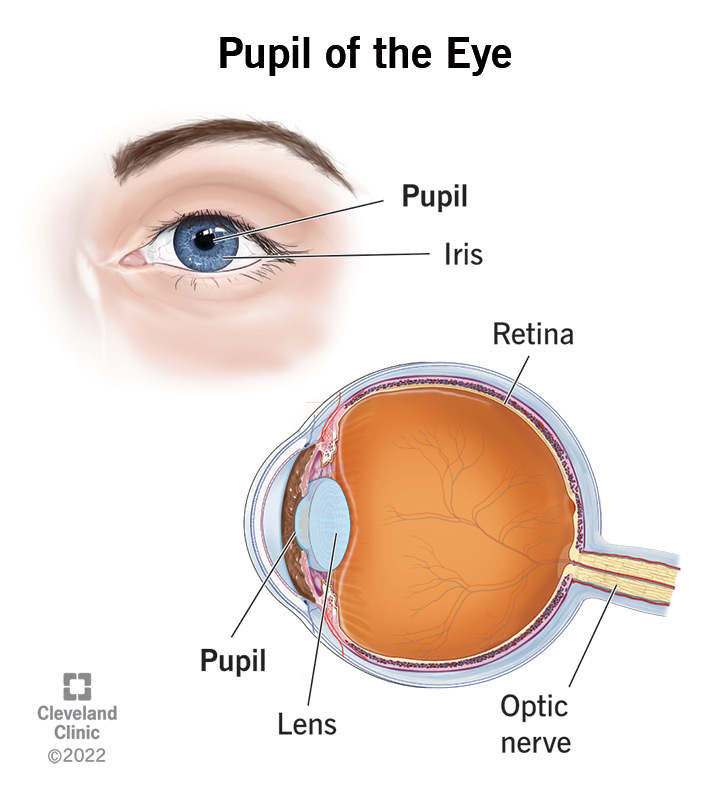The pupil is the black opening in the middle of the colored part of your eye (iris). The pupil gets bigger or smaller in response to changes in light. Muscles in the iris control the size of the pupil. Pupil issues can suggest certain diseases.
Advertisement
Cleveland Clinic is a non-profit academic medical center. Advertising on our site helps support our mission. We do not endorse non-Cleveland Clinic products or services. Policy

The pupil of your eye is the black hole in the middle of your iris. Your iris is the colored part of your eye. Muscles in your iris control how big the pupil is. Usually, this happens as a result of how much light is available. This makes the pupil an important part of your vision system.
Advertisement
Cleveland Clinic is a non-profit academic medical center. Advertising on our site helps support our mission. We do not endorse non-Cleveland Clinic products or services. Policy
When you’re in bright light, your pupil constricts and gets smaller. When the light is dim, your pupil dilates and gets bigger. The name of this reaction is the pupillary light response.
The pupil has protection. The cornea is a clear dome over the eye that covers the pupil and provides protection. Another layer of tissue called the conjunctiva also protects the pupil and the whole eye.
Your pupil lets light into your eye as the muscles of your iris change its shape. The lens in your eye focuses light that passes through your pupil. Light then goes to the back of your eye and hits your retina.
Your retina turns light into electrical signals. Your brain receives these signals and turns them into images. This is how you’re able to see.
Two muscles in your iris control how you pupil opens and closes. The iris dilator muscle opens your pupil from the inside out. It sort of looks like a sun with rays extending out from the middle. The iris sphincter is a circular muscle that controls closing your pupil.
Nerves that affect the pupil connect to the afferent pathway (the path from your eye to your brain). They also connect to the efferent pathway (the path from your brain to your eye).
Advertisement
The pupil also gives aqueous humor a pathway to the front of your eye. Aqueous humor is a fluid that nourishes your eyes.
The pupil looks like a black hole. It looks black because light usually stays inside your eye. One of the few times that you might see light coming back out of your eye is in a photograph. That’s why you might see red-looking eyes in pictures taken with a flash. This is light reflecting off the blood vessels in your eyes.
A variation in pupil size can be an issue itself or a symptom of other conditions. Common conditions of the pupil of the eye include:
An eye care specialist may do tests to tell if your eyes are healthy, including:
Advertisement
Treating eye conditions depends on what’s causing them. For instance, if your current medication affects your pupils, a provider may suggest that you stop taking that drug or substitute another medicine.
Some conditions may require medication. Often, these may be in the form of eye drops or topical preparations (like ointments that you apply to your skin).
Other forms of medications may come in oral form (pills, capsules or liquids). You’ll get some drugs as an injection (a shot) and others through a vein (intravenously or IV).
Providers may treat some eye conditions with eye exercises or surgery.
There are things you can do to keep your eyes healthy. These include:
Advertisement
Your pupils are important parts of your vision system. Problems with your pupils can point a healthcare provider toward a diagnosis of other illnesses. See an eye care specialist as often as they suggest. It’s also good to do what you can to keep yourself and your eyes healthy.
Advertisement
Getting an annual eye exam at Cleveland Clinic can help you catch vision problems early and keep your eyes healthy for years to come.

Last reviewed on 10/04/2022.
Learn more about the Health Library and our editorial process.